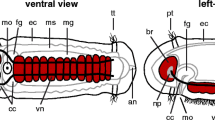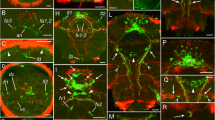Abstract
We examined the development of the nervous system in Aurelia (Cnidaria, Scyphozoa) from the early planula to the polyp stage using confocal and transmission electron microscopy. Fluorescently labeled anti-FMRFamide, antitaurine, and antityrosinated tubulin antibodies were used to visualize the nervous system. The first detectable FMRFamide-like immunoreactivity occurs in a narrow circumferential belt toward the anterior/aboral end of the ectoderm in the early planula. As the planula matures, the FMRFamide-immunoreactive cells send horizontal processes (i.e., neurites) basally along the longitudinal axis. Neurites extend both anteriorly/aborally and posteriorly/orally, but the preference is for anterior neurite extension, and neurites converge to form a plexus at the aboral/anterior end at the base of the ectoderm. In the mature planula, a subset of cells in the apical organ at the anterior/aboral pole begins to show FMRFamide-like and taurine-like immunoreactivity, suggesting a sensory function of the apical organ. During metamorphosis, FMRFamide-like immunoreactivity diminishes in the ectoderm but begins to occur in the degenerating primary endoderm, indicating that degenerating FMRFamide-immunoreactive neurons are taken up by the primary endoderm. FMRFamide-like expression reappears in the ectoderm of the oral disc and the tentacle anlagen of the growing polyp, indicating metamorphosis-associated restructuring of the nervous system. These observations are discussed in the context of metazoan nervous system evolution.






Similar content being viewed by others
References
Berking S (1988) Taurine found to stabilize the larval state is released upon induction of metamorphosis in the hydrozon hydractinia. Roux’s Arch Dev Biol 197:321–327
Borchiellini C, Manuel M, Alivon E, Boury-Esnault N, Vacelet J, Le Parco Y (2001) Sponge paraphyly and the origin of Metazoa. J Evol Biol 14:171–179
Brusca RC, Brusca GJ (2003) Invertebrates. Sinauer, MA
Campbell RD, Josephson RK, Schwab WE, Rushforth NB (1976) Excitability of nerve-free hydra. Nature 262:388–390
Chia FS, Bickell L (1978) Mechanisms of larval settlement and the induction of settlement and metamorphosis: a review. In: Chia F-S, Rice ME (eds) Settlement and metamorphosis of marine invertebrate larvae. Elsevier, New York, pp 1–12
Chia FS, Koss R (1979) Fine-structural studies of the nervous-system and the apical organ in the planula larva of the sea-anemone Anthopleura elegantissima. J Morph 160:275–298
Collins AG, Schuchert P, Marques AC, Jankowski T, Medina M, Schierwater B (2006) Medusozoan phylogeny and character evolution clarified by new large and small subunit rDNA data and an assessment of the utility of phylogenetic mixture models. Syst Biol 55:97–115
Davis LE (1974) Ultrastructural studies of development of nerves in hydra. Am Zool 14:551–573
de Jong DM, Hislop NR, Hayward DC, Reece-Hoyes JS, Pontynen PC, Ball EE, Miller DJ (2006) Components of both major axial patterning systems of the Bilateria are differentially expressed along the primary axis of a ‘radiate’ animal, the anthozoan cnidarian Acropora millepora. Dev Biol 298:632–643
Dunn CW, Hejnol A, Matus DQ, Pang K, Browne WE, Smith SA, Seaver E, Rouse GW, Obst M, Edgecombe GD et al (2008) Broad phylogenomic sampling improves resolution of the animal tree of life. Nature 452:745–749
Eakin RM (1982) Continuity and diversity in photoreceptors. In: Westfall JA (ed) Visual cells in evolution. Raven, New York, pp 91–105
Epstein DJ, Vekemans M, Gros P (1991) Splotch (Sp2H), a mutation affecting development of the mouse neural tube, shows a deletion within the paired homeodomain of Pax-3. Cell 67:767–774
Grimmelikhuijzen CJP (1983) FMRFamide immunoreactivity is generally occurring in the nervous systems of coelenterates. Histochemistry 78:361–381
Groger H, Schmid V (2001) Larval development in Cnidaria: a connection to Bilateria? Genesis 29:110–114
Halanych KM (2004) The new view of animal phylogeny. Ann Rev Ecol Evol Syst 35:229–256
Harris W, Hartenstein V (1998) Determination of neural fate. In: Bloom F, Landis S, Roberts J, Squire L, Zigmond M (eds) Fundamental neuroscience. Academic, New York, pp 481–518
Hatten M, Heintz N (1998) Neurogenesis and migration. In: Bloom F, Landis S, Roberts J, Squire L, Zigmond M (eds) Fundamental neuroscience. Academic, New York, pp 451–480
Hayakawa E, Fujisawa C, Fujisawa T (2004) Involvement of Hydra achaete–scute gene CnASH in the differentiation pathway of sensory neurons in the tentacles. Dev Genes Evol 214:486–492
Hayward DC, Catmull J, Reece-Hoyes JS, Berghammer H, Dodd H, Hann SJ, Miller DJ, Ball EE (2001) Gene structure and larval expression of cnox-2Am from the coral Acropora millepora. Dev Genes Evol 211:10–19
Hernandez-Nicaise M-L (1991) Ctenophora. In: Harrison FW (ed) Microscopic anatomy of invertebrates, vol 2. Wiley-Liss, New York, pp 359–418
Jacobs DK, Nakanishi N, Yuan D, Camara A, Nichols SA, Hartenstein V (2007) Evolution of sensory structures in basal metazoa. Integr Comp Biol 47:712–723
Jones WC (1962) Is there a nervous system in sponges. Biol Rev Camb Philos Soc 37:1–50
Katsukura Y, David CN, Grimmelikhuijzen CJP, Sugiyama T (2003) Inhibition of metamorphosis by RFamide neuropeptides in planula larvae of Hydractinia echinata. Dev Genes Evol 213:579–586
Kim J, Kim W, Cunningham CW (1999) A new perspective on lower metazoan relationships from 18S rDNA sequences. Mol Biol Evol 16:423–427
Korn H (1966) Zur ontogenetischen Differenzierung der Coelenteratengewebe (Polyp-Stadium) unter besonderer Berücksichtigung des Nervensystems. Z Morph Ökol Tiere 57:1–118
Leitz T, Lay M (1995) Metamorphosin-a is a neuropeptide. Roux’s Arch Dev Biol 204:276–279
Leitz T, Morand K, Mann M (1994) Metamorphosin A: a novel peptide controlling development of the lower metazoan Hydractinia echinata (Coelenterata, Hydrozoa). Dev Biol 163:440–446
Lentz TL (1965) Fine structure of differentiating interstitial cells in hydra. Z Zellforsch Mikrosk Anat 67:547–560
Marques AC, Collins AG (2004) Cladistic analysis of Medusozoa and cnidarian evolution. Invertebr Biol 123:23–42
Martin VJ (1992) Characterization of a RFamide-positive subset of ganglionic cells in the hydrozoan planular nerve net. Cell Tissue Res 269:431–438
Martin VJ (2000) Reorganization of the nervous system during metamorphosis of a hydrozoan planula. Invertebr Biol 119:243–253
Martin VJ, Thomas MB (1980) Nerve elements in the planula of the hydrozoan Pennaria tiarella. J Morphol 166:27–36
Martin VJ, Thomas MB (1981) The origin of the nervous-system in Pennaria tiarella, as revealed by treatment with colchicine. Biol Bull 160:303–310
Martin VJ, Chia FS (1982) Fine-structure of a scyphozoan planula, Cassiopeia xamachana. Biol Bull 163:320–328
Martin V, Chia FS, Koss R (1983) A fine-structural study of metamorphosis of the hydrozoan Mitrocomella polydiademata. J Morphol 176:261–287
Martindale MQ (2005) The evolution of metazoan axial properties. Nat Rev Genet 6:917–927
Medina M, Collins AG, Silberman JD, Sogin ML (2001) Evaluating hypotheses of basal animal phylogeny using complete sequences of large and small subunit rRNA. Proc Natl Acad Sci U S A 98:9707–9712
Nordstrom K, Wallen R, Seymour J, Nilsson D (2003) A simple visual system without neurons in jellyfish larvae. Proc R Soc Lond B Biol Sci 270:2349–2354
Pavansde M (1974) Coordination in sponges—foundations of integration. Am Zool 14:895–903
Plickert G (1989) Proportion-altering factor (Paf) stimulates nerve-cell formation in Hydractinia echinata. Cell Differ Dev 26:19–27
Plickert G, Schneider B (2004) Neuropeptides and photic behavior in Cnidaria. Hydrobiologia 530:49–57
Putnam NH, Srivastava M, Hellsten U, Dirks B, Chapman J, Salamov A, Terry A, Shapiro H, Lindquist E, Kapitonov VV et al (2007) Sea anemone genome reveals ancestral eumetazoan gene repertoire and genomic organization. Science 317:86–94
Sakarya O, Armstrong KA, Adamska M, Adamski M, Wang I-F, Tidor B, Degnan BM, Oakley TH, Kosik KS (2007) A post-synaptic scaffold at the origin of the animal kingdom. PLoS ONE 2:e506
Salvini-Plawen L, Splechtna H (1979) On the origin and evolution of lower Metazoa. Zool Syst Evol Forsch 16:40–88
Schmich J, Trepel S, Leitz T (1998) The role of GLWamides in metamorphosis of Hydractinia echinata. Dev Genes Evol 208:267–273
Skeath JB, Zhang Y, Holmgren R, Carroll SB, Doe CQ (1995) Specification of neuroblast identity in the Drosophila embryonic central nervous system by gooseberry-distal. Nature 376:427–430
Technau U, Rudd S, Maxwell P, Gordon PM, Saina M, Grasso LC, Hayward DC, Sensen CW, Saint R, Holstein TW et al (2005) Maintenance of ancestral complexity and non-metazoan genes in two basal cnidarians. Trends Genet 21:633–639
Thomas M, Edwards N (1991) Cnidaria: Hydrozoa. In: Harrison FW (ed) Microscopic anatomy of invertebrates, vol. 2. Wiley-Liss, New York, pp 91–183
Thomas MB, Freeman G, Martin VJ (1987) The embryonic origin of neurosensory cells and the role of nerve-cells in metamorphosis in Phialidium gregarium (Cnidaria, Hydrozoa). Int J Invertebr Reprod Dev 11:265–285
Wallberg A, Thollesson M, Farris JS, Jondelius U (2004) The phylogenetic position of the comb jellies (Ctenophora) and the importance of taxonomic sampling. Cladistics 20:558–578
Weis V, Buss L (1987) Ultrastructure of metamorphosis in Hydractinia echinata. Postilla 199:1–20
Weis VM, Keene DR, Buss LW (1985) Biology of hydractiniid hydroids. 4. Ultrastructure of the planula of Hydractinia echinata. Biol Bull 168:403–418
Widersten B (1968) On the morphology and development in some cnidarian larvae. Zool Bidr Upps 37:139–182
Wolpert L (2007) Principles of development. Oxford University Press, Oxford, New York
Yuan D, Nakanishi N, Jacobs DK, Hartenstein V (2008) Embryonic development and metamorphosis of the scyphozoan Aurelia. Dev Genes Evol 218. doi:10.1007/s00427-008-0254-8
Acknowledgements
We thank Mike Schaadt and Kiersten Darrow of the Cabrillo Marine aquarium, San Pedro, CA, for providing us with the Aurelia material. This work was supported by the UCLA Edwin W. Pauley fellowship (to N.N.) and the NASA Astrobiology Institute. We also thank anonymous reviewers for helping us to improve the clarity of the manuscript.
Author information
Authors and Affiliations
Corresponding author
Additional information
Communicated by M.Q. Martindale
Rights and permissions
About this article
Cite this article
Nakanishi, N., Yuan, D., Jacobs, D.K. et al. Early development, pattern, and reorganization of the planula nervous system in Aurelia (Cnidaria, Scyphozoa). Dev Genes Evol 218, 511–524 (2008). https://doi.org/10.1007/s00427-008-0239-7
Received:
Accepted:
Published:
Issue Date:
DOI: https://doi.org/10.1007/s00427-008-0239-7




